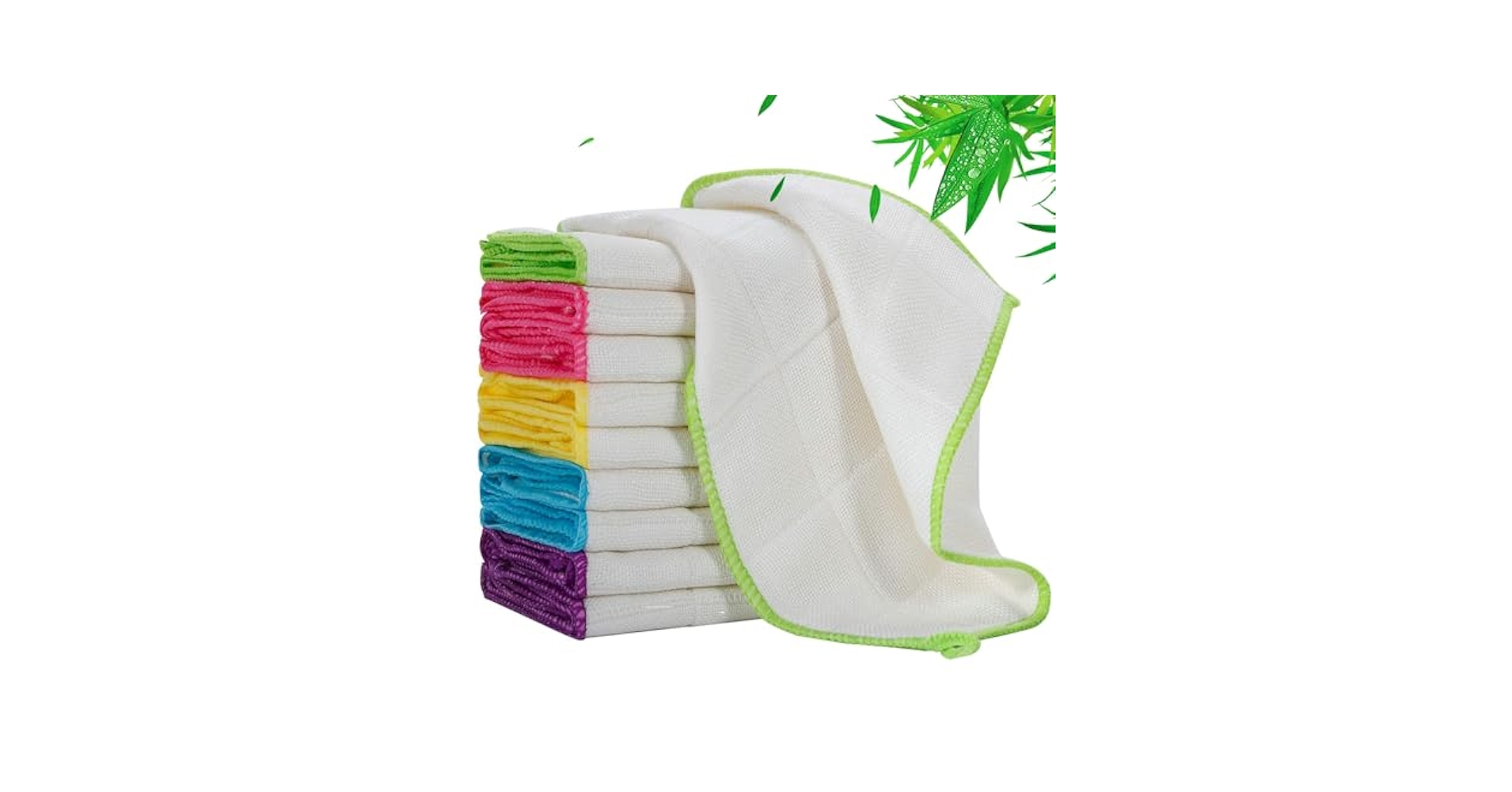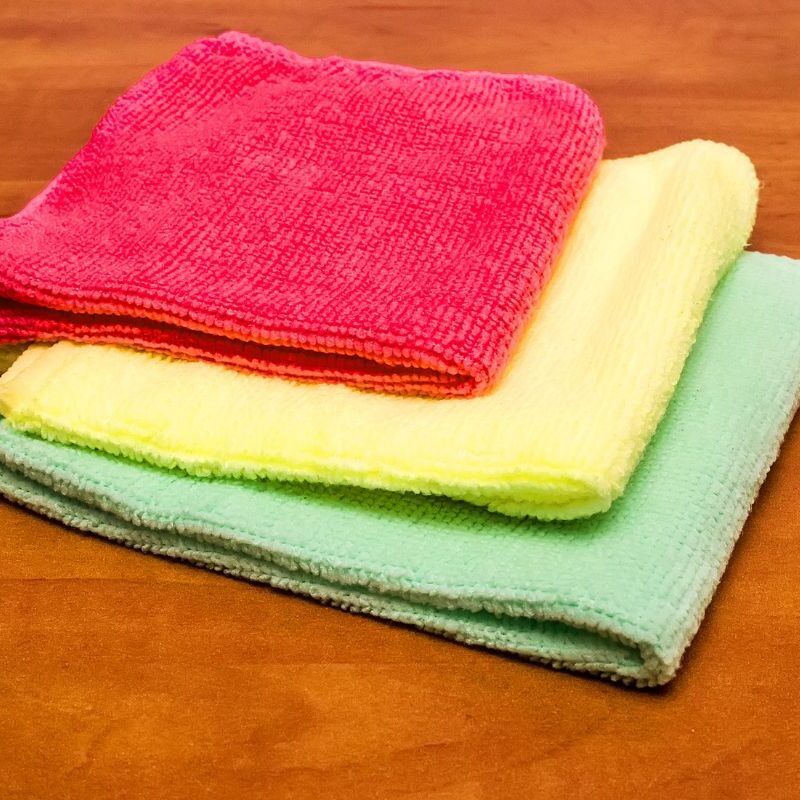Are you tired of stubborn streaks and smudges ruining your clean surfaces? Choosing the right cleaning cloth can make all the difference.
When it comes to keeping your home spotless, you might be wondering: should you go for bamboo cleaning cloths or stick with microfiber cloths? Each has its own benefits, but which one truly fits your needs? Keep reading, and by the end, you’ll know exactly which cloth will make your cleaning faster, easier, and better for your home.
Eco-friendly Materials
Choosing cleaning cloths made from eco-friendly materials helps protect the planet. Bamboo and microfiber cloths are popular options. Each has different environmental impacts based on their raw materials and production processes.
Bamboo Fiber Properties
Bamboo fibers come from fast-growing bamboo plants. Bamboo grows without pesticides or much water. It captures carbon dioxide and releases oxygen. Bamboo fibers are biodegradable and break down naturally. The fabric feels soft and is strong. It resists odors and bacteria without chemicals. Bamboo is a renewable resource that regrows quickly after harvest. Using bamboo cloths reduces reliance on synthetic fibers.
Microfiber Composition
Microfiber cloths are made from synthetic fibers like polyester and polyamide. These fibers come from petroleum, a non-renewable resource. Microfiber production involves chemical processes that can harm the environment. The cloths are durable and clean well with little water. Microfiber does not decompose easily and can release tiny plastic particles. These microplastics may pollute oceans and harm wildlife. Washing microfiber cloths requires care to limit plastic pollution.
Cleaning Performance
Cleaning performance is key when choosing cloths for your home. Both bamboo and microfiber cloths offer good results. Understanding how they perform helps you pick the best option. This section compares their absorbency, streak-free use, durability, and longevity.
Absorbency And Streak-free Use
Bamboo cloths absorb water very well. They soak up spills quickly and hold moisture. This makes cleaning easier without leaving wet spots.
Microfiber cloths also have strong absorbency. Their tiny fibers trap dirt and liquid effectively. This helps clean surfaces without spreading mess.
Both cloths clean glass and mirrors with little streaking. Bamboo’s natural fibers leave a soft finish. Microfiber can remove grease and smudges fast. Choosing depends on the surface and cleaning needs.
Durability And Longevity
Bamboo cloths tend to be strong and last long. They resist wear even after many washes. Their fibers stay intact, keeping cleaning power steady.
Microfiber cloths are durable but may lose effectiveness over time. Frequent washing can break down fibers. Proper care extends their life.
Overall, bamboo cloths offer long-term use with good strength. Microfiber works well but may need replacing sooner. Consider your cleaning frequency and cloth care.
Environmental Impact
Choosing cleaning cloths affects the planet more than most realize. The materials and processes used to make cloths impact the environment. Bamboo and microfiber cloths have different effects on nature and waste. Understanding these differences helps make better choices for a cleaner earth.
Production Footprint
Bamboo grows fast and needs little water or pesticides. This makes its farming less harmful to the land. Bamboo cloths require less energy to produce compared to synthetic fibers. Microfiber cloths come from petroleum-based plastics. Extracting and processing these plastics uses much energy and pollutes air and water. The production of microfiber cloths leaves a larger carbon footprint than bamboo.
Biodegradability And Waste
Bamboo cleaning cloths break down naturally after disposal. They return nutrients to the soil without leaving harmful residues. Microfiber cloths do not decompose easily. They shed tiny plastic fibers when washed, polluting waterways and harming wildlife. These microplastics accumulate in oceans and soil. Using bamboo cloths reduces plastic waste and helps protect ecosystems.

Credit: www.amazon.com
Health And Safety
Choosing the right cleaning cloth matters for health and safety. Both bamboo and microfiber cloths have unique traits. These traits affect how safe and healthy they are to use daily.
Chemical Exposure
Bamboo cloths come from natural fibers. They usually need fewer chemicals during production. This reduces the risk of harmful residues on the cloth. Microfiber cloths are made from synthetic materials. They can sometimes hold chemicals from manufacturing. Some may also release tiny plastic fibers when washed. These fibers could affect indoor air quality and health. Bamboo cloths tend to be gentler on the skin and lungs.
Allergy Considerations
Bamboo cloths are hypoallergenic. They rarely cause skin irritation or allergies. People with sensitive skin often prefer bamboo. Microfiber cloths can cause irritation in some users. The synthetic fibers may trigger allergies or rashes. Washing microfiber thoroughly can reduce this risk. Bamboo’s natural fibers offer a safer choice for allergy sufferers.
Cost And Availability
Cost and availability are important factors when choosing between bamboo cleaning cloths and microfiber cloths. Both types offer benefits, but their prices and how easy they are to find can influence your choice. Understanding these differences helps you pick the best option for your budget and needs.
Price Comparison
Bamboo cleaning cloths often cost more than microfiber cloths. Bamboo material is natural and eco-friendly, which can increase its price. Microfiber cloths are usually cheaper because they are made from synthetic fibers and mass-produced. The price difference can vary depending on brand and quality. Some buyers pay extra for bamboo cloths due to their sustainability.
Market Accessibility
Microfiber cloths are widely available in many stores and online shops. They are common household items found in supermarkets and cleaning supply stores. Bamboo cloths are less common but becoming easier to find. Specialty eco-friendly shops and online markets often sell bamboo cloths. Availability depends on your location and the type of store you visit.
Care And Maintenance
Proper care and maintenance keep your cleaning cloths effective and lasting longer. Bamboo and microfiber cloths require gentle handling to preserve their texture and cleaning power. Understanding how to wash and maintain these cloths helps avoid damage and reduces waste. Let’s explore simple steps to care for your bamboo and microfiber cloths.
Washing Tips
Wash bamboo cloths in cold or warm water to keep fibers soft. Use mild detergent without bleach or fabric softener. Avoid hot water that can shrink or weaken bamboo fabric. Microfiber cloths clean best in warm water with gentle detergent. Skip fabric softeners; they clog microfiber strands and reduce absorbency. Wash each type separately to prevent fiber damage. Air dry bamboo cloths to avoid heat damage. Microfiber cloths can be tumble dried on low heat. Avoid ironing both types to keep fibers intact.
Longevity Practices
Store cloths in a dry, clean place to prevent mildew and odors. Rinse cloths after use to remove dirt and grime quickly. Avoid using bamboo cloths on rough surfaces that cause pilling. Do not use microfiber cloths with harsh chemicals or bleach. Replace cloths once they lose softness or cleaning ability. Regular maintenance extends the life of bamboo and microfiber cloths. Proper care means fewer replacements and better cleaning results.
User Experiences
User experiences provide clear insights into how bamboo cleaning cloths and microfiber cloths perform. Real feedback helps understand their strengths and weaknesses. Consumers share practical details about texture, durability, and cleaning power. These reviews guide others in choosing the right cloth for daily use.
Customer Reviews
Many users praise bamboo cloths for being soft and gentle on surfaces. They like that bamboo cloths feel natural and eco-friendly. Some find them perfect for sensitive skin and delicate items.
Microfiber cloths receive high marks for their strong cleaning ability. Users say these cloths pick up dust and dirt quickly. Many appreciate that microfiber cloths dry fast and do not leave streaks.
Some customers mention bamboo cloths work well for light cleaning tasks. Others note microfiber cloths handle tough stains better. Both cloth types have loyal fans who prefer one over the other based on cleaning needs.
Common Complaints
A frequent complaint about bamboo cloths is their slower drying time. Some users feel bamboo cloths wear out faster after many washes. A few report bamboo cloths can smell if left damp too long.
Microfiber cloths sometimes get criticized for scratching delicate surfaces. Some users say the cloths attract lint and hair easily. Others find microfiber cloths less eco-friendly due to synthetic fibers.
Both cloth types have drawbacks based on personal use and care habits. Understanding these common issues helps buyers make better choices and care for their cloths properly.

Credit: www.alibaba.com

Credit: www.swagify.com
Frequently Asked Questions
What Are The Main Differences Between Bamboo And Microfiber Cloths?
Bamboo cloths are natural, biodegradable, and hypoallergenic. Microfiber cloths are synthetic, durable, and excellent at trapping dirt and dust. Bamboo is eco-friendly but less abrasive, while microfiber offers superior cleaning power and quick drying. Both serve different cleaning needs effectively.
Are Bamboo Cleaning Cloths More Environmentally Friendly?
Yes, bamboo cloths are biodegradable and made from a renewable resource. They decompose naturally, reducing landfill waste. Microfiber cloths are plastic-based and may shed microplastics during washing. Bamboo is a greener choice for sustainable cleaning practices.
Which Cloth Is Better For Sensitive Skin Cleaning?
Bamboo cloths are softer and hypoallergenic, making them ideal for sensitive skin. Microfiber cloths can sometimes irritate skin due to synthetic fibers. For gentle cleaning, bamboo is the preferred option to avoid irritation and allergies.
How Do Bamboo And Microfiber Cloths Compare In Durability?
Microfiber cloths generally last longer due to synthetic fibers that resist wear and tear. Bamboo cloths are durable but may degrade faster with frequent washing. Proper care can extend the life of both cloth types.
Conclusion
Choosing between bamboo and microfiber cloths depends on your needs. Bamboo cloths feel soft and are eco-friendly. Microfiber cloths clean well and dry quickly. Both types help keep surfaces spotless. Think about what matters most to you—nature or fast cleaning.
Either way, both cloths make cleaning easier. Try both to see which fits your style best. Clean smarter, not harder.
